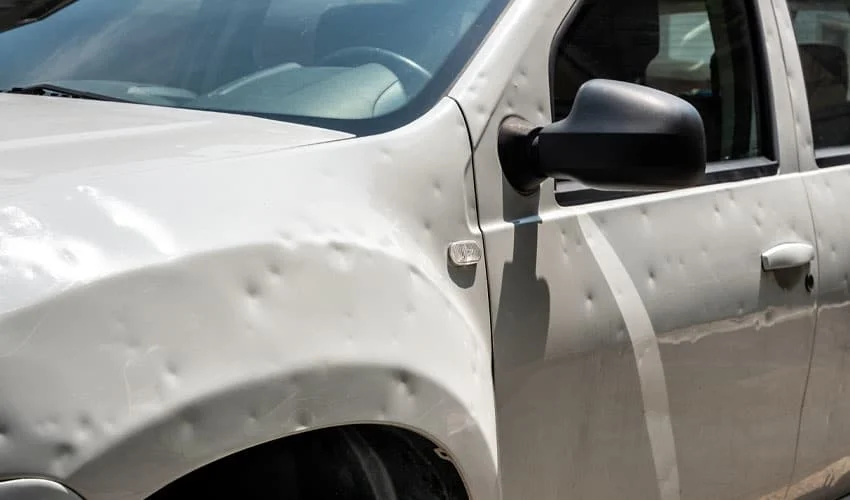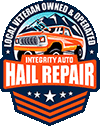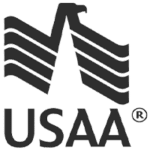Hailstorms can leave your vehicle covered in unsightly dents and dings, prompting a need for auto hail damage repair. While paintless dent repair (PDR) is an effective and popular solution, it’s essential to avoid common mistakes that could end up costing you more money. Whether you’re considering DIY repairs or hiring a professional, understanding these pitfalls can save you from unnecessary expenses and ensure your vehicle is restored correctly.

Attempting DIY Repairs Without Proper Knowledge
Why It’s a Mistake?
Many car owners are tempted to tackle auto hail damage themselves, especially with the availability of DIY PDR kits. While these kits might seem like a cost-effective solution, they often require a level of skill and expertise that most amateurs lack. Without the proper knowledge and technique, you risk making the damage worse.
Potential Costs
- Increased Damage: Incorrect use of tools can lead to further dents or even damage to the paint, resulting in higher repair costs.
- Reduced Resale Value: Poorly executed repairs can be evident, decreasing your vehicle’s resale or trade-in value.
- Professional Intervention Needed: You might still need to hire a professional to fix the mistakes, doubling your expenses.
Solution
Unless you have experience with doing paintless dent repairs (PDR) yourself, it’s usually best to leave auto hail damage repair to the professionals. They have the training and specialized tools necessary to perform the job correctly.
Choosing the Cheapest Repair Option
Why It’s a Mistake?
Opting for the least expensive repair service can be tempting, but it often leads to subpar results. Some repair shops may cut corners, use inferior materials, or lack the necessary expertise to perform quality PDR. Companies like Integrity Auto Hail Repair only work with experienced and certified PDR technicians with years of experience.
Potential Costs
- Poor Quality Repairs: Cheap repairs might look acceptable initially but can deteriorate quickly, leading to more repair costs down the road.
- Hidden Damage: Inadequate repairs may not address all the damage, particularly hidden or micro-damage, compromising the vehicle’s structural integrity.
- Frequent Repairs: Low-quality work might necessitate frequent visits to the repair shop, cumulatively costing more than a single high-quality repair.
Solution
Do your research and choose a reputable auto hail damage repair service. Look for PDR specialists with good reviews and a proven track record, even if they charge slightly more. The upfront investment is worth the assurance of quality work. But the good news is that many good PDR shops such as Integrity Auto Hail Repair can restore your car for free in most cases.
Missing Hidden Damage
Why It’s a Mistake?
Hail damage isn’t always visible to the naked eye. Micro-damage beneath the surface can affect the structural integrity of your vehicle. Ignoring this hidden damage can lead to long-term issues.
Potential Costs
- Structural Weakness: Unaddressed micro-damage can weaken the vehicle’s body, making it more susceptible to future damage.
- Increased Repair Costs: Over time, small issues can escalate into significant problems requiring extensive and expensive repairs.
- Insurance Complications: If hidden damage isn’t documented and repaired initially, it may complicate future insurance claims.
Solution
Always have a professional PDR company inspect your vehicle after a hailstorm. They can identify and address all damage, including hidden issues, ensuring a comprehensive repair.
Delaying Repairs
Why It’s a Mistake?
Procrastination can be costly when it comes to hail damage. Delaying repairs allows dents to settle and become harder to fix, and it can also expose your vehicle to further damage from the elements.
Potential Costs
- Worsened Damage: Over time, untreated dents can lead to rust and corrosion, particularly if the paint is chipped or cracked.
- Higher Repair Costs: The longer you wait, the more complex and expensive the repairs can become.
- Insurance Issues: Delaying repairs might complicate insurance claims, possibly denying coverage, especially if additional damage occurs while waiting.
Solution
Schedule repairs as soon as possible after a hailstorm. Prompt action can prevent further damage and keep repair costs manageable.
Not Consulting with Your Insurance Company
Why It’s a Mistake?
Failing to involve your insurance company can result in missed opportunities for coverage and increased out-of-pocket expenses. Many car owners avoid filing claims due to the fear of increased premiums or the perceived hassle. The good news is that hail damage repair when done by a professional company does not impact your insurance premiums.
Potential Costs
- Out-of-Pocket Expenses: Without filing a claim, you might end up paying for repairs entirely out of your pocket.
- Missed Benefits: Insurance policies often cover hail damage repairs, including PDR, and may offer additional benefits such as rental car coverage.
- Claim Denials: Delaying or avoiding the claims process can lead to claim denials or complications, particularly if additional damage occurs before the initial damage is repaired.
Solution
Always consult with your insurance company after hail damage. Companies like Integrity Auto Hail Repair can assist in handling claims, ensuring you get the coverage you’re entitled to and reducing your financial burden.
Conclusion
Avoiding these 5 common mistakes can save you significant money and ensure your vehicle is properly restored after a hailstorm. While DIY repairs and cheap options might seem attractive, they often lead to more expenses in the long run. Investing in professional auto hail damage repair, promptly addressing damage, and consulting with your insurance company are the best strategies to protect your vehicle’s value and integrity.
Remember, reputable PDR services like Integrity Auto Hail Repair offer comprehensive solutions, including dealing with insurance claims and providing rental car assistance, making the repair process as smooth and cost-effective as possible. When it comes to hail damage, taking the right steps from the start can save you both time and money.












